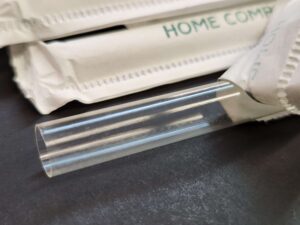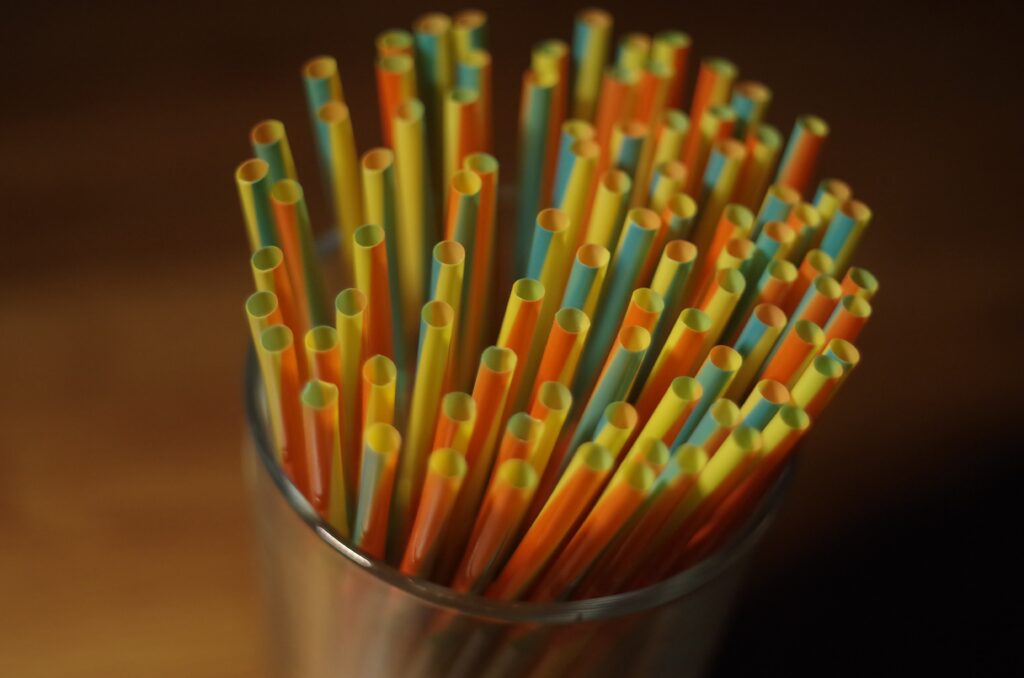Compostable drinking straws are increasingly becoming a popular option for those looking to become more eco-friendly while reducing their environmental footprint. Compostable drinking straws are a more sustainable alternative to regular plastic straws. Straws come in varying lengths and diameters. They come wrapped and unwrapped.
Why Choose Eco-Friendly Compostable Straws
Compostable straws are usually made of natural or “biodegradable” materials, so they break down quickly when composted. They can also be composted in soil or in a marine environment, making them more environmentally friendly and safe for our planet.
Unlike traditional plastic straws which may take many years to break down, compostable drinking straws are designed to decompose in a matter of weeks and easily mix into compostable soil. Despite their rapid decomposing rate, however, compostable drinking straws are still known to last longer than regular plastic drinking straws, while requiring minimal care and maintenance.
Types of Compostable Straws
Compostable straws are made from compostable materials that, when composted, break down into natural elements within a period of weeks. Biodegradable drinking straws are an even better choice as they can still compost, but they also have the capability to naturally break down in the soil and marine environments.
It’s important to be aware that not all compostable drinking straws are created equal — some break down faster than others, and some will only compost under certain conditions. Some require an industrial composting facility to break down, while others can break down in your backyard compost heap naturally in weeks leaving no remaining microplastics behind.
There are numerous materials used to make compostable straws. Several of the most popular eco straws are as follows:
Paper Straws
Paper straws are made by gluing together 3 sheets of lightweight kraft paper. Those 3 sheets are formed around a rod or mandrel to form a tube. The paper tube is then cut to length. Paper straws are often run thru a heater to make the straws dry and firm.
While the paper used in paper straws is inherently biodegradable, a number of manufacturers are placing water-resistant coatings on the outer and inner surfaces to make those straws water-resistant. It is unknown how this water-resistant coating affects the biodegradability of the paper straw and whether the coating is leaving microplastics in the soil once it breaks down. Compostable straws should not contain any wax coating or dryer lint-type fibers that could leach toxins into drinks.
The biggest drawback of paper straws is that they often fall apart in your lips after a few sips. Many note a paper aftertaste and the unwanted texture of the paper when placed against the lips, or tongue.
Paper straws can be made in varying diameters and colors. They are considered disposable and some may be recycled. However, paper straws are notorious for becoming soggy within 30 minutes.
Bamboo Drinking Straws
Bamboo straws are made by harvesting bamboo stalks which are hollow and make for a naturally formed straw. The stalks are cut to a desired length. They then undergo extensive cleaning and burnishing to ensure that no loose debris falls into your drink when used.
Bamboo straws are certainly sustainable and eco-friendly, they do not lend themselves to specific diameters or coloring.
Bamboo straws are considered disposable, but not necessarily recyclable.
Biodegradable Rice Straws
Compostable and biodegradable rice straws are made from a mixture of flour, corn starch, tapioca starch, potato starch, and potato whole wheat flour all mixed together to make a slurry that is then extruded to form tubes. These tubes are then cut to length and dried to form the rice straw.
While rice straw raw material is all natural and sustainable, the straws themselves can often be brittle in use. They can be made in varying diameters and colors.
Rice straws are considered disposable and not recyclable.
Eco Glass Straws
Borosilicate glass is often used as eco-glass drinking straws. Production tubes of glass are made to length, then cut to straw length. The straws will undergo burnishing to remove sharp edges.
Glass straws are considered reusable; not disposable. Glass straws can be washed and reused. Of course, the glass itself can be recycled. Care should be taken not to break a glass straw as it could cause bodily harm.
Eco-Friendly Metal Straws
Metals straws are commonly made from tubes of stainless steel. They are considered reusable; not disposable, and are commonly sold with a hand brush to wash the straw’s inside diameter.
Stainless steel straws commonly cost more and are most commonly found in households versus restaurants.
Compostable PLA Straws
PLA straws are often referred to as “biodegradable” when they are really not. True, they are made from naturally occurring materials, but the PLA plastic straw itself is not necessarily environmentally friendly.
PLA straws are made from a resin that is heated and extruded into tube form. The tube is cut to length to form the drinking straw.
As many people consider PLA straws to be compostable, consumers have a false sense that PLA straws can be thrown away in the trash where they will disintegrate. This is not true.
PLA straws require an industrial compost facility to break down.
PLA straws are a bit brittle compared to other bioplastic straws. They can come in various colors as well. They are considered disposable.
Nodax Straws, Phade Straws
Nodax ™ is the trade name for the material used to make Phade straws. The material itself is 100% renewable and is made from corn, sugar beet, and/or vegetable oils. It forms a biopolymer that is then heated and extruded to form tubes. These tubes are cooled and cut to length to make drinking straws.
The Nodax ™ material is certified OK compost HOME and BPI Industrial Compostable.
The material manufacturer has recently been engaged in a class-action lawsuit for making false claims that the straws are marine biodegradable when they are not. Though the material itself is certified as marine biodegradable, no such certification exists for drinking straws. Hence the lawsuit for false advertising.
These straws are translucent in appearance and have a slight texture to them. Some consumers have reported occasional brittleness and cracking when using the straw. They come in natural off-white or blue.
These straws are considered disposable; not recyclable.
KonzaWare Biodegradable Drinking Straws
 KonzaWare straws are made of sustainable wood pulp that is transformed into a biodegradable plastic resin. The resin is extruded to form tubes, which are then cooled and cut to length to form compostable drinking straws.
KonzaWare straws are made of sustainable wood pulp that is transformed into a biodegradable plastic resin. The resin is extruded to form tubes, which are then cooled and cut to length to form compostable drinking straws.
KonzaWare straws are clear in appearance and provide consumers the superior sipping experience that they are used to when they use a regular plastic straw. They are flexible and durable.
KonzaWare straws are certified by TUV AUSTRIA as OK home COMPOST or “home compostable”. That means you can throw them away in your backyard compost where they will disintegrate in weeks leaving no remaining microplastics behind. Micro-organisms eat the straw material, which in turn, creates healthy soil for plant life.
Marine Biodegradability of Compostable Straws
Single-use plastic waste continues to fill our oceans. So wouldn’t it be great if there were a plastic straw that was marine biodegradable?
Sure it would. Unfortunately, there is no such thing as a “marine biodegradable” straw.
Danimer Scientific and Phade straws have a Class Action lawsuit against them for false advertising. They claimed Phade straws are marine biodegradable when they are not.
Articles like straws cannot be certified as “marine biodegradable”. Only raw materials can be certified as marine biodegradable.
The reason is that they don’t want people throwing straws in the ocean thinking that the straws will biodegrade as that promotes pollution.
The material used to make KonzaWare straws is certified marine biodegradable. That means that it will disintegrate naturally over time when exposed to a marine environment.
Cost of Compostable Straws
Compostable drinking straws often cost more than regular plastic straws since their production costs are slightly higher; however, this extra cost is justified when taking into account the environmental impacts of plastic pollution from non-biodegradable products.
Of all the types of compostable drinking straws, paper straws are the least costly. However, they often times provide the worst consumer sipping experience when the straw falls apart in the lips.
KonzaWare straws last for hours.. even days. And they are priced like that of paper drinking straws. So they’re affordable for almost everyone. Go here for compostable straws.

